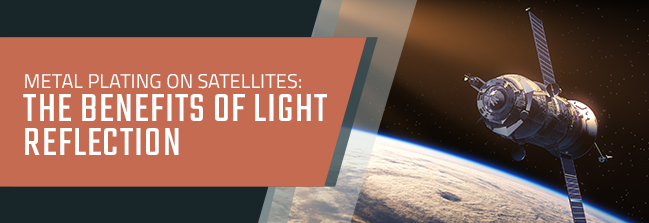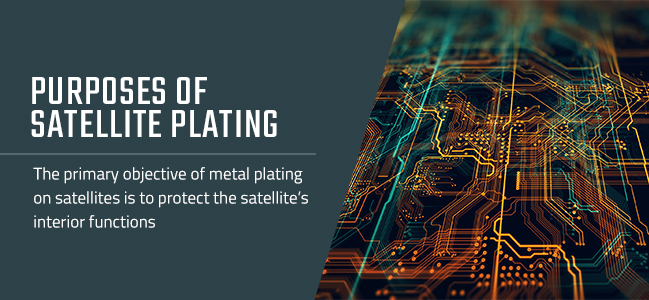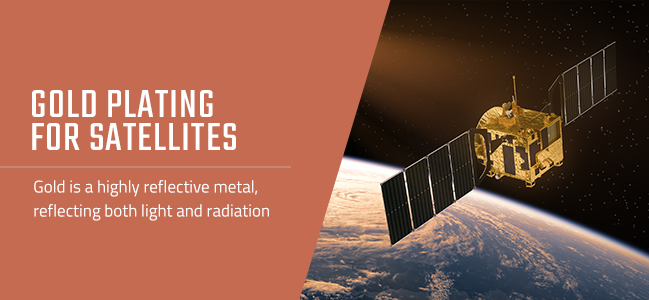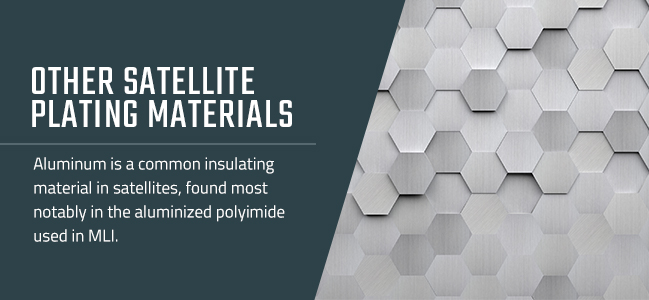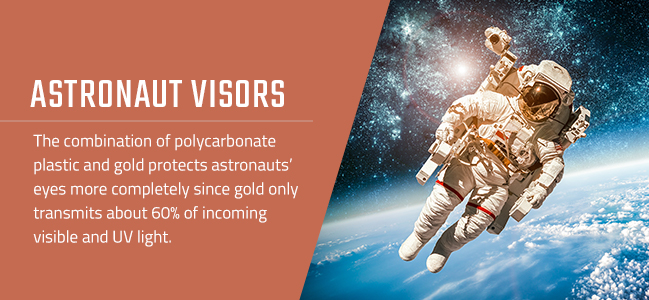Hundreds of advanced technologies on earth employ metal plating as an integral part of their function, from industrial electronics to automotive machining. Those applications don’t end in the earth’s atmosphere, however. Metal plating has countless applications in spacecraft and satellite design, from electronic satellite components to telescopes. Read on to learn more about how metal plating is essential to humanity’s spaceflight and research efforts.
Challenges in Satellite Design
The materials used to cover the exteriors of spacecraft face numerous environmental threats, both within the atmosphere and outside of it, that can degrade and damage equipment and materials. While most people recognize the threat posed by the vacuum of space, there are hundreds of other threats to satellites and spacecraft, which must be mitigated by satellite design choices. These include:
- Extreme Light: The light emitted by the sun is substantially more powerful than what we experience on earth. That is because the earth’s atmosphere either absorbs or dissipates the light — as light enters the atmosphere, light particles bounce off molecules in the air, dispersing the light more evenly. Without the atmosphere to protect them, satellites are exposed to much more sunlight, which can cause problems in the form of glare and heat. Satellite designers will often rectify this with metallic insulation plating designed to reflect and absorb light.
- Heat Radiation: Like light, the heat radiated by the sun is much stronger outside the earth’s atmosphere. This increased heat is because the sun transmits heat to the Earth by warming the atmosphere, like a pie in a convection oven. Directly radiated heat is what is experienced in space — this stronger, more direct heat treats any object more like a hot dog in a microwave. The heat resulting from direct radiation can severely disrupt and damage electronic equipment but can be mitigated with reflective coatings and metallic plating with heat transfer capabilities.
- Thermal Cycling: Satellites go through many quick thermal cycles as they orbit a planet, passing in and out of the sun’s light path. The International Space Station (ISS), for example, orbits Earth once every 92 minutes, meaning that it goes through 16 thermal cycles in a single day. Scientists on the ISS have observed that many coatings subjected to these quick thermal changes degrade quickly, especially when there is a mismatch between the coating and substrate in their coefficients of thermal expansion (CTEs).
- Atomic Oxygen: Atomic oxygen (AO) is produced when UV radiation interacts with oxygen atoms in the upper atmosphere. This is a substantial problem for satellites orbiting at this level since AO oxidizes and corrodes metals much more quickly than oxygen at ground level. Silver, copper and osmium are particularly susceptible, as are polymers containing carbon, nitrogen and hydrogen bonds. Anti-corrosive metals are often used to counteract the adverse effects of AO.
- Debris: Satellites orbit the Earth and other planets at incredible speeds — the ISS, for example, travels at an orbital velocity of about 7.6 km/s, or 4.7 miles/s. At this speed, even small objects, like micrometeoroids, can be extremely damaging, as they travel up to 60 km/s. Strong coatings, therefore, are essential for maintaining the integrity of a satellite’s exterior.
Some of these effects, like radiation and thermal cycling, can be mitigated using multilayer insulation, or MLI, a gold-colored insulation material commonly seen on the outside of satellites. This insulative material consists of several layers, including thin aluminum, polyimide and polyester, resulting in a lightweight, reflective film that has a golden look. Insulation doesn’t work everywhere, however, which is where plating comes into play.
Purposes of Satellite Plating
The primary objective of metal plating on satellites is to protect the satellite’s interior functions, from electronics to mechanical components to even astronauts, from the negative effect listed above. This helps guarantee continued function and protects the lives of astronauts working in space. Satellite plating primarily does this through:
- Light Reflection: Gold is a highly reflective substance, reflecting wavelengths in and out of the visible spectrum. The best thing, however, is that gold absorbs some amounts of light in the visible spectrum, reducing the amount of light reflected. This means that reflected light isn’t quite as intense. Both effects are particularly useful for protecting astronauts from blinding light, both direct and reflected.
- Heat Management: The delicate instrumentation within a satellite is highly susceptible to heat buildup. Though insulation can help shield interior electronics, externally placed electronics may not be able to function with insulation. Plating is the best solution, reflecting incoming heat radiation while transferring and dissipating heat from the equipment’s interior environment.
- Radiation Protection: Radiation is one of the biggest concerns for satellites since there is no atmosphere to protect their delicate internal electronics from radiation damage when they are orbiting the earth or traveling through space. A metal plating of gold, silver or even copper helps to protect these internal electronics by reflecting UV and infrared radiation.
Gold Plating for Satellites
Several types of metal plating are used in satellites depending on the component in question. While some are used in exterior applications, others are used for internal components. The most notable of these coatings is gold. In fact, gold is so popular for plating space equipment, that it’s the subject of an old NASA joke: “Why are spacecraft coated with gold? Because solid gold ones are too expensive.”
NASA and other space flight organizations use gold in several contexts, from reflectors to electronic connections. While this abundant use of gold may seem like a budgetary waste, especially since NASA has been quite vocal in the past about their financing, it makes sense when you understand the utility of gold. After all, when you’re sending a team of highly trained astronauts and millions of dollars of equipment above the earth’s atmosphere, anything less than the best is unacceptable. But what makes gold the best?
Gold is one of the most uniquely workable metals in existence, and though we tend to equate gold with money, it has much more than monetary value. Gold possesses several uniquely valuable properties, including:
- Corrosion-Resistance: While metals like silver and copper tarnish easily, gold stays pure and shiny. This is because of gold’s corrosion-resistance. Gold doesn’t react with particles in the atmosphere, even AO, meaning that it’s easier to maintain both at ground level and in the upper atmosphere.
- Reflectivity: Gold is a highly reflective metal, reflecting both light and radiation. Gold reflects infrared radiation with wavelengths above 0.7 µm as well as any other metal, keeping electronics cool. It also reflects more UV radiation below 0.35 µm than other metals.
- Light Absorption: As well as being reflective, gold absorbs a great deal of visible light. This means that any light that hits a gold-plated substance will reflect out at a fraction of the intensity. This absorption means that reflections are less likely to create hotspots or blind astronauts working in and around satellites. This absorptive property is also helped by the element’s heavy atomic weight, which allows it to absorb quite a bit of light before starting to heat up.
- Malleability: Gold is a very soft metal, remaining malleable when stretched. It’s also a more forgiving material, folding and unfolding with little difficulty or creasing. This makes the material easier to work with during manufacturing. This malleability can be problematic, however, in external satellite applications where debris is an issue. This is often managed by covering gold coatings with layers of glass or other clear materials.
- Conductivity: Gold is both electrically and thermally conductive. This means that gold allows heat to dissipate across its surface with relative ease, making heat management a much easier task. Electrical conductivity is also important, as gold is often used for long-lasting electrical connections in satellites.
Until another material is discovered that improves upon the functionality of gold with greater cost efficiency, gold electroplating for satellites will continue to be the standard in many space applications.
Other Satellite Plating Materials
Gold isn’t the only plating material commonly found in satellite applications. Other metal plating materials include:
- Silver: Silver is used in hundreds of applications across the world, and satellites and spacecraft are no different. In fact, NASA’s Magellan spacecraft used silver-coated quartz tiles as protection from solar radiation. Though this method has largely fallen out of favor compared to gold, particularly due to its susceptibility to oxidization, it is still a popular plating for many interior functions, and research about its continued use in satellites and spacecraft technology is still underway.
- Copper: Copper is commonly used throughout electronic applications for its electrical conductivity, and is most commonly found in circuit boards, the basis of most modern electronics. Most of the sensitive electronic equipment used in satellites, particularly research satellites, uses this PCB technology.
- Aluminum: Aluminum is a common insulating material in satellites, found most notably in the aluminized polyimide used in MLI.
Many other coatings are also used in satellite applications, though their usage depends most strongly on the conditions in which the spacecraft will operate.
Other Deep Space Uses for Metal Plating
Satellites aren’t the only deep space applications in which metal plating is used. Spacecraft, as well as aerospace components, tools and suits, employ metal plating in their production processes to lend certain properties and traits to their equipment. For example, metallic plating is commonly used in the following aerospace applications:
- Telescopes: Telescopes use mirrors to reflect and focus light for observation purposes. While terrestrial telescopes use glass, space exploration entities make the mirrors in space telescopes with a stronger, more heat-resistant material called beryllium. While this material is highly reflective, these properties are amplified by a thin, 100nm-thick coating of gold, which reflects infrared light very well and helps focus light from distant objects. This gives telescopes like the new James Webb space telescope a slightly gold look.
- Collectors: Gold is also used in many space collectors. For this equipment, the state of the gold piece is analyzed and assayed before and after a space mission. This helps determine the types of particles the collector was exposed to in space.
- Electronics: Many electronics and microelectronics on board spacecraft are made using gold. This use is primarily because gold is an excellent electrical conductor. Additionally, gold is very resistant to corrosion and static buildup, making it a good choice for long-lasting electrical contacts. Since it’s hard to get replacement electronics when you’re out in space, longevity is key.
- Visors: If you’ve ever seen a picture of an astronaut out in space, you may have noticed the slight golden tinge to their visor. This gold color occurs because space suit visors are made of a polycarbonate plastic coated with a very thin layer of gold. This combination protects astronauts’ eyes more completely than just polycarbonate or gold since gold only transmits about 60% of incoming visible and UV light. Gold is also useful because it reflects almost all infrared light, which can do the most harm to astronauts’ eyes since humans have no infrared receptors to tell us when infrared light is harming our eyes. When combined with polycarbonate plastic, which absorbs and reflects almost all UV light, astronauts get complete visual protection in their visors.
- Future Applications: Scientists affiliated with NASA and other space exploration entities continue to research the applications of metallic coatings in spacecraft and satellite applications. For example, researchers at the University of Delaware are currently considering a method for converting carbon dioxide into carbon monoxide using a silver electrocatalyst. This electrocatalyst, made by coating silver on an electrode, produces oxygen atoms with this method at a 92 percent efficiency rate. The method could help recycle oxygen in a spacecraft’s closed air system with greater efficiency.
Additional applications, from hull coatings to PCB plating, continue to be used and researched by entities like NASA and their affiliates to find the best materials and processes for satellite and aerospace applications.
Choose Sharretts Plating for Satellite Plating
If your company is looking for a professional plating company for your satellite applications, SPC is the best available. SPC has over nine decades of experience in a wide variety of plating applications, including aerospace and satellite applications. Our gold electroplating service for satellites uses gold that is 99% pure or more, meaning that your satellite components are plated with the best materials possible. No matter what you need, SPC will develop a customized plating process to fit your application.
Learn more about SPC and our gold and silver electroplating processes for satellites by contacting us today. Call us now to discover what we can do for your company and a free, no-obligation quote for your next satellite production project.


